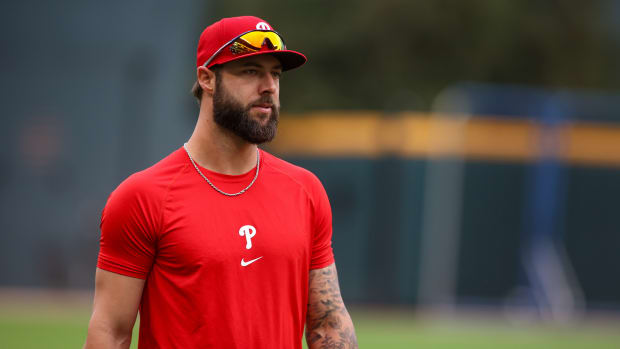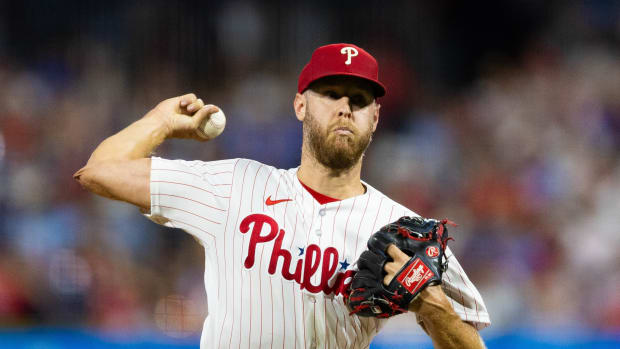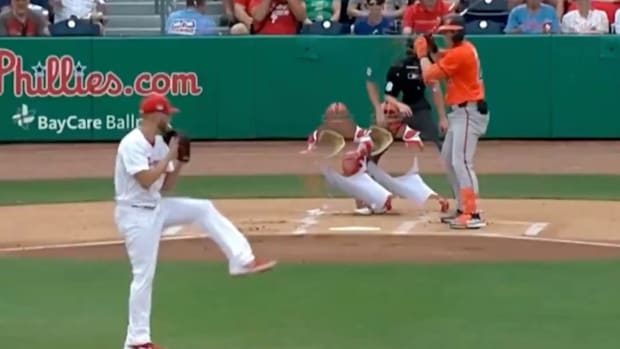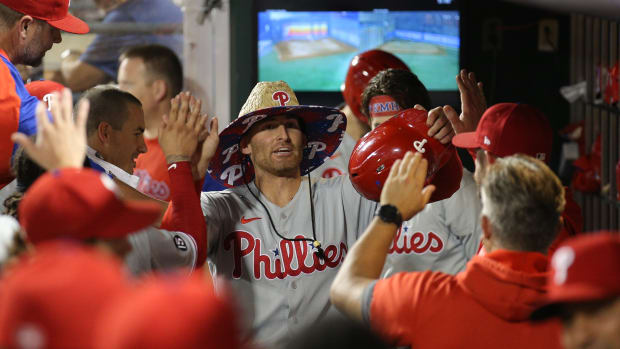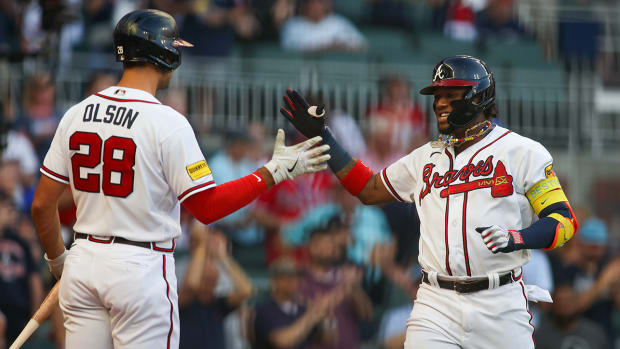Exclusive Interview: The Pioneering Claire Smith, First Black Female Baseball Reporter
Where were you when Derek Jeter made his infamous 'flip play' to tag out Jeremy Giambi at home plate in Game 3 of the 2001 ALDS? How about when a 6.9 magnitude earthquake interrupted the 1989 World Series between the San Francisco Giants and Oakland Athletics? Or when the New York Yankees and Boston Red Sox took their rivalry across the pond to London?
Claire Smith was there. She took in those moments with her own eyes, just as she did with countless other Major League Baseball games throughout her 40-year sports writing career. And for the first time in the history of the sport, the game was being taken in from a journalistic perspective by a woman.
Smith broke barriers in 1983 when she became the first woman on the MLB beat, covering the New York Yankees for the Hartford Courant until 1987. She also held jobs at The New York Times as a columnist from 1991 to 1998, and at The Philadelphia Inquirer as an editor and columnist from 1998 to 2007.
Smith credits her mother, Bernice Anastasia Ximines Smith, for getting her ‘hooked’ on baseball through her tales of Jackie Robinson and the Brooklyn Dodgers. "My mother was one of the most interesting people I've ever known,” Smith said. "The roadblocks I faced were trivial compared to what she faced."
Before her mother immigrated to the United States from Jamaica, she claimed that Jamaicans “worshiped everything American,” and would gather around a shortwave radio to listen to broadcasts of boxer Joe Louis’ fights.
Bernice arrived in the U.S. in 1945, just after Robinson had signed with the Dodgers, making her a lifelong fan. October 3, 1951 was a date that Smith’s mother never forgot for two reasons. That day Smith’s older brother, William Jr., was born. But it was also the same day New York Giants outfielder Bobby Thomson hit the “shot heard ‘round the world” off of Dodgers’ pitcher Ralph Branca at the Polo Grounds to capture the National League pennant. That’s how deep her fandom went.
“She told me the stories, she told me about Jackie and the Dodgers, and I just picked it up from her,” Smith said. “My dad liked Willie Mays, and therefore I liked the Giants, but it didn’t quite capture my imagination as much as Jackie did.”
Bernice was born in New York City, but was sent back to her family's native Jamaica when she was an infant. There, she excelled in school and was sent on a commercial ship to England to attend college. But the ship had to turn around and dock in Philadelphia, as the war had broken out.
While in Philadelphia, Bernice was able to reunite with her parents, whom she hadn't seen since she was a child. She attended John W. Hallahan Catholic Girls' High School and upon graduation, enrolled at Temple University with the goal of becoming a doctor. But after her father died, she had to drop out of Temple, unable to afford the tuition. She transferred to Morgan State in Baltimore, Md., a historically Black college, and continued her medical studies. There, she met her husband, and Smith’s father, William Sr.
Bernice was a bit of a “perfectionist,” as Smith describes. After she received a "B" in Biology, she switched her major to Chemistry and graduated with a degree in that field instead. She worked for General Electric in Philadelphia in the department that handled rocketry and missiles, she even aided NASA in getting their ships off the ground and into space.
“Both [parents] are my heroes, as you can imagine…1945 was not a great time to be Black in America. It was certainly better than what their parents went through. My dad actually knew his grandfather who was born into slavery,” Smith said. “So, each generation had its challenges, but I learned long ago not to compare, because nothing I go through can ever, ever compare to seeing my mom being chased out of a drugstore in Maryland because they didn’t serve Blacks, or sitting with my dad in the car waiting for a gas attendant to come out and put gas in the car and eventually coming to the realization that this person was not going to come out and serve us because we were Black.”
Smith continued, "Just those slights that hit my parents, and hit them and hit them, but they never stopped them. So, my being chased out of a locker room is laughable if compared to what they went through or what their parents went through.”
On October 2, 1984, while Smith was covering the NLCS between the Chicago Cubs and San Diego Padres, she was removed from the Padres’ locker room following Game 1 due to her gender. While there were other ‘slights’ she faced during her career, Smith says that getting pushed out of that clubhouse nearly 40 years ago was the “one really bad moment” she experienced.
“I felt really alone, there was a sense of desperation because my job too was to write the game story, and as the only reporter there from the Courant, I had to tell both sides of the game,” she said. “I needed the Padres. They had lost, they were in foul moods. I still needed some reaction before I went over to the Cubs.”
At the time, the National League did not have a universal policy on women in the locker room; it was instead left up to each team. Smith said there were about three or four teams that women in the industry could identify as “troll spots,” meaning clubhouses where they did not feel welcome. The Padres were one of them.
That night, Smith had a letter in her possession from the National League. It said her credentials would be honored and she would have no problem gaining access to the clubhouse because it was ultimately controlled by the league. Despite the letter, that was not the case that October night in 1984.
“A certain group of players started chirping and cursing, and demanding that I be shown out [of the clubhouse],” recalled Smith. “I was the only woman reporter in the clubhouse after the game. Club personnel…I don’t know if they were trainers or what, but people started yelling. General Manager Jack McKeon was there, and I went up to him and said, ‘Jack, I have permission to be in here from the league,’ and he stated that it was Manager Dick Williams’ clubhouse. The procession of people behind me started pushing me towards the door; at least one person put hands on me to push me towards the door.”
The game took place at Cubs’ home Wrigley Field, and at that time, the stadium was nearly 70 years old. The structure was small, as one can imagine. “I didn’t have to take a lot of steps to be pushed out,” Smith said. “As I was being ushered out, Dick Williams was coming in from the interview room, and I said, ‘I have permission and the credentials to be in here, but your team is saying I have to leave,’ and his response was, ‘That’s right,’ and he kept walking in as I was being pushed out.”
There Smith stood in the dank, awful underbelly of Wrigley Field, feeling an incredible sense of loneliness and uncertainty of what to do. Just then, Henry Hecht of the New York Post, a friend of Smith’s on the Yankees’ beat, approached Smith as he entered the clubhouse from the interview room and asked her what she needed.
“I need quotes,” she responded. At that point, the Padres’ Public Relations Director came out as well, he asked Smith which players she needed quotes from. The PR Director later returned and said those players were unavailable. However, Smith requested for Hecht to get Steve Garvey. Smith and Garvey were friends, dating back to her early days as a Dodgers fan when she was in high school and college, and she’d see them play in Philadelphia. Smith claims she was a “real fangirl” and would get autographs and talk with the players as they left the stadium after the game.
Hecht went into the clubhouse to retrieve Garvey from a sea of reporters, as he was one to stick around after a loss and carry the weight of it for the team, according to Smith. Hecht told him that Smith was outside and that she had been kicked out of the clubhouse. Garvey excused himself from the reporters and came out of the locker room to help Smith out.
“When I saw him, I started to tear up. What had happened was just starting to hit hard,” Smith said. “Steve said to me, something that I now identify as the most important thing I ever heard in my 40-year career. He said he’d stay there for as long as I needed, but I had to get myself together because I had a job to do. And it’s exactly what I needed to hear.”

Steve Garvey is recognized by Claire Smith during her acceptance speech after receiving the BBWAA Career Excellence Award at Doubleday Field on July 29, 2017.
© Gregory Fisher-USA TODAY Sports
Smith conducted the interview with Garvey, got the quotes she needed for her story, and then headed over to the Cubs’ clubhouse. What had happened to Smith had already reached the Cubs, and players and coaches Smith had covered while they were on the Yankees were livid at what had happened. On the Padres' side, Hall of Famer Goose Gossage was just as furious. He questioned why Smith didn’t seek him out, as he would’ve intervened on her behalf, which Smith knew was a bad idea considering Goose might’ve gotten violent. And that was just the beginning of the outrage.
The next day, it was the media’s turn to be outraged. Smith’s peers, even the Baseball Writers Association, got involved. Smith’s editor at the time, Jon Pessah, told her that she had to go back into that locker room even if it meant they’d have her arrested, which Smith teases him about to this day.
Peter Ueberroth had just taken over as MLB Commissioner, and this was his first controversy. He issued a statement that said any reporter who is properly credentialed is allowed into Major League clubhouses. Full stop. Period. Thus, taking away the issue.
But, the story continued rolling. By the time the series moved to San Diego, the locker room was full of female reporters and television anchors. Smith encountered Williams again in the tunnel at Jack Murphy Stadium, “Why aren’t you in there? All of the other women are in there,” he quipped and kept walking.
“It was a much bigger story than I ever wanted,” Smith said. “I was taught that reporters never want to be the story, and there I was, in the middle of these stories with Padres being questioned and grilled by columnists and national baseball writers. They became pariahs. It became much more widely known that they had members of the John Birch Society on the team, because those were basically the players that were cursing at me.”
The John Birch Society is a far-right group that has been accused of believing in white supremacy. So, whether those players berated Smith in regard to her race, her gender, or both, she’ll never know, but the discrimination she faced for either was never a competition. “It was the first time I ever had to think in terms of race, and thank God, it was the last time,” she said. “People always ask me which was harder, being African American or being a woman, and it was never, ever a contest.”
From that point on, players like Tony Gwynn and the rest of the Padres looked out for Smith, as well as other ‘allies’ throughout the league, that women reporters identified and passed on through word of mouth to seek out. Many of these ‘allies’ were Black players, who understood what it was like to be hazed.
“It hurt for a long time, I’m not going to lie,” Smith said. “I was kind of spreading my stuff from ‘82 to ‘84, that yeah, I can walk into any clubhouse, and after ‘84, there was something mental there that was frightening about going into clubhouses that I wasn’t familiar with, because you never knew what was on the other side of the door.”
While the landscape of sports journalism has made significant progress since the incident Smith faced in 1984, women in the field still face similar obstacles, but they’ve now manifested themselves in different ways—the main culprit being social media.
When Smith’s career began, she could only be criticized through letters in the mail, and later through email. “I can’t even imagine being victimized, or stalked, or trolled on Twitter. I don’t even know if I’d be on there regularly covering a team and had to put up with gender bias, and other ignorance,” Smith said. “I talk to women, and I see the pain that they suffer online.”
Smith then recalled in 2016 when ABC News rolled out a video where men read mean tweets sent to female sports reporters, and saw the shock on their faces while repeating some of the horrible comments made to them online. “Not until I guess our male counterparts and the males that we cover come face to face with it, are they really in tune with the burdens that women carry.”
So why do women do it? Why do they cover the sport for nine months out of the year? Why do they enter into an industry where they know they’re going to face sexist remarks? Because of their love of the game, says Smith.
“You can’t cover baseball for 40 years if you don’t love it as an art form, as something beautiful, something that requires so much skill,” Smith said. “To me, it’s artistic. It’s a ballet. Even watching batting practice—it’s a ballet. When the grounders are hit, when the ball comes off the bat from the hitter in the cage, everything is timed so perfectly. The choreography of it is pretty amazing.”
MLB has taken a big step forward in terms of their willingness to hire women for “upper-level” positions throughout the league, both on and off the field. The Miami Marlins hired Kim Ng as general manager in 2020, making her the highest-ranked female baseball executive. Also in 2020, the San Francisco Giants hired Alyssa Nakken as the first full-time female coach in MLB history, becoming the first woman to coach on the field during a major league game. And just this year, the Yankees hired Rachel Balkovec as the first woman to work as full-time manager for a major league-affiliated team. These are a few strides that have been made in recent years. Just as Smith broke barriers for women in the press box and clubhouse, Ng, Nakken and Balkovec have broken barriers on the field and front office.
But the hiring of these women proves one thing: women have been qualified for these positions all along. Smith believes MLB can continue working on its inclusivity by promoting and building women up from within. The best way for MLB to prove they're dedicated to women's involvement in the sport is supplying equal opportunities in hiring, moving qualified women up the ranks in their own organizations, and making sure they receive fair representation in internships.
Smith was bestowed the BBWAA Career Excellence Award (formerly known as the J.G. Taylor Spink Award) in 2017, awarded annually "for meritorious contributions to baseball writing" by the Baseball Writers' Association of America (BBWAA). Smith was the first woman, and fourth African-American, to receive the award.

Hall of Fame President Jeff Idelson, Kathleen Lowenthal, Claire Smith, National Baseball Hall of Fame Chairman of the Board Jane Forbes Clark, and MLB commissioner Rob Manfred pose for photo at Clark Sports Center on July 30, 2017.
© Gregory Fisher-USA TODAY Sports
Smith received the call during the 2016 Winter Meetings. She went in front of about 100 baseball writers the next day to accept her nomination, BBWAA secretary/treasurer Jack O'Connell made the announcement and elicited a standing ovation.
“It was overwhelming. I thought of my mom and my dad, and I thought that they kept me going. They really did,” Smith said, choking back tears. “When I was told they wanted me to come up to the front to make some comments, I asked all the women in the room to come share it with me. Because the award was to be shared with them, because I wouldn’t have been able to make it without them.”
When Smith walked up on stage to speak, there were about 20 women standing behind her. In 40 years, Smith went from being the first woman on the MLB beat, able to count on one hand how many women were also covering the sport, to having four times that number standing up on stage supporting her in 2016.
She no longer felt that feeling of loneliness that struck her back in 1984. Smith stated that she hopes that experience isn’t what’s "carved on her tombstone or what’s the second paragraph in her obituary," because it was one really bad day in 40 years of coverage, and she hopes her coverage outweighs that. Certainly, receiving that prestigious award showed how valuable her contributions were to baseball writing.
“That moment…it was the culmination. I told my son that day I made the speech because he asked me what it meant. And I told him, it means everything, and it still does.”
At the bottom of Smith's email signature reads a quote from Jackie Robinson: "A life is not important except in the impact it has on other lives.” Smith has lived up to the words of the baseball player who had captured her imagination all those years ago. Just as Jackie inspired so many through his life, Smith has done the same through her own.
More From SI's Inside The Phillies:
- Implications of Nick Castellanos Signing for the Phillies
- Assessing the Phillies' Center Field Decision
- Dombrowski and Girardi Speak From Phillies Spring Training
- Will Zack Wheeler be Ready for Opening Day?
- How did Philadelphia end up with Citizens Bank Park?
- How the Phillie Phanatic Came to be America's Favorite Sports Mascot
- How Mike Trout Will Join the Phillies
- Predicting the Phillies 2022 Opening Day Roster
- Picking the Phillies' All-Time Single Season Lineup
- The Sad Story of the Phillies' First Black Ballplayer
Make sure to follow Inside the Phillies on Facebook and Twitter!

